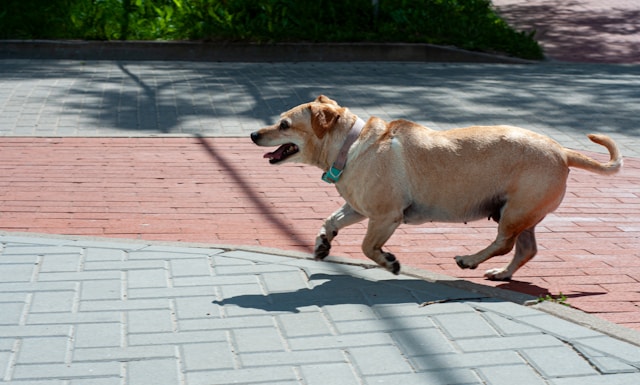Exercising your pet is essential for their physical and mental well-being, but when temperatures rise, it’s important to be cautious. Hot weather can pose serious health risks for pets, especially during outdoor activities. However, that doesn’t mean your pet has to stay indoors all summer. With the right approach, you can keep your pet active while minimizing the risks associated with heat.
This guide will show you how to safely exercise your pet in hot weather, offering pet heat safety tips, recommended activities, and signs to watch out for to prevent heat-related health issues.
Understanding the Risks of Exercising Pets in Hot Weather
Before you head out with your dog or let your cat roam the backyard, it’s essential to understand the dangers that hot weather poses.
Heatstroke and Dehydration
When pets become overheated, they can quickly suffer from heat exhaustion or heatstroke both of which can be fatal if not treated promptly. Unlike humans, pets don’t sweat to cool down (except for minor sweating through paw pads), so they rely on panting and limited body mechanisms to regulate temperature.
Burned Paw Pads
Sidewalks, asphalt, and sand can become scorching hot during the summer. Pets can burn their paw pads just by walking on hot surfaces for a few minutes. A good rule of thumb is: if it’s too hot for your hand or bare feet, it’s too hot for theirs.
Breathing Difficulties
Some breeds, especially short-nosed (brachycephalic) dogs like bulldogs, pugs, and boxers, are more prone to overheating. They struggle to breathe efficiently in hot, humid conditions and need extra caution during summer activities.
Best Times to Exercise Your Pet
One of the most important pet heat safety tips is to avoid the hottest part of the day.
Choose Cooler Hours
-
Early Morning (before 9 AM) and Late Evening (after 6 PM) are usually the safest times for outdoor exercise.
-
Avoid walking or playing during peak sun hours typically 10 AM to 4 PM when heat and UV exposure are at their worst.
Monitor Humidity
High humidity reduces the effectiveness of panting, which can make it harder for pets to cool off. Always consider both temperature and humidity when planning activities.
Safe Summer Pet Activities
Exercising pets in hot weather doesn’t have to be intense. Focus on gentle, creative activities that keep your pet stimulated without overexertion.
Shaded Walks
Stick to shaded trails or tree-lined streets. Keep walks shorter than usual and bring water for both you and your pet.
Water-Based Play
-
Let your dog splash in a kiddie pool or sprinkler.
-
Go for a safe swim in a clean lake, river, or dog-friendly pool.
-
Avoid strong currents and supervise at all times.
Indoor Activities
If it’s too hot outside, stay inside with fun, low-impact activities like:
-
Puzzle feeders or treat-dispensing toys
-
Hide-and-seek games
-
Obedience training or trick practice
-
Tug-of-war or fetch in an air-conditioned space
Dog Parks with Shade
If your dog enjoys socializing, visit parks early or late in the day that have plenty of shade, water stations, and grassy areas.
Essential Safety Tips for Hot Weather Dog Walking and Play
Here are practical steps to make sure your summer pet outings stay safe and enjoyable:
-
Keep pets hydrated at all times. Bring a portable water bowl and stop for water breaks regularly.
-
Check pavement temperature with your hand or a thermometer. Stick to grass or dirt paths when possible.
-
Use cooling gear like vests, bandanas, or mats designed to lower body temperature.
-
Limit intensity and duration reduce how long and how fast your pet walks or runs.
-
Never leave pets in a parked car, even for a minute. Temperatures can rise dangerously in moments.
Signs of Overheating to Watch For
Recognizing early symptoms of heat-related issues can save your pet’s life. Stop activity immediately and move to a cool, shaded area if you notice:
-
Excessive panting or drooling
-
Lethargy or collapsing
-
Red or pale gums
-
Rapid heart rate
-
Vomiting or diarrhea
-
Disorientation or wobbling
If symptoms persist or worsen, seek veterinary care immediately. Preventing pet heatstroke starts with staying alert.
Breed and Age Considerations
Some pets are more vulnerable to heat than others. Tailor your exercise plans accordingly:
Senior Pets and Puppies
Older animals and young pets can’t regulate body temperature as effectively. Keep their activity light and indoors when possible.
Brachycephalic Breeds
Breeds like pugs, Boston terriers, French bulldogs, and Persian cats are at high risk for heat exhaustion. Minimize their exposure to heat and avoid any vigorous activity outdoors.
Heavy-Coated Breeds
Dogs with thick coats (like Huskies or Golden Retrievers) can overheat quickly. Consider trimming excess fur (consult a groomer) and ensure they have access to shade and water at all times.
Conclusion
Hot weather doesn’t mean exercise has to stop it just means you need to be smart and intentional about it. By choosing the right time of day, modifying your activities, and being aware of signs of overheating, you can keep your pet happy, healthy, and safe all summer long.

